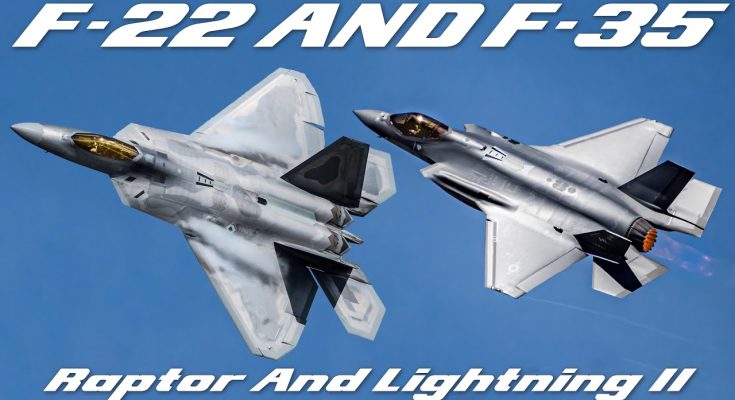The F-22 Raptor and the F-35 Lightning II are two of the most advanced fighter jets ever produced by the United States. These aircraft represent the cutting-edge of military aviation, combining stealth, speed, agility, and advanced technology to maintain American air superiority in modern warfare. While both are designed with similar goals—air dominance and multirole capabilities—they are different in terms of their specific missions, design philosophies, and technological features.
F-22 Raptor: The Air Superiority King
The F-22 Raptor was designed primarily for air superiority. Developed by Lockheed Martin and introduced into service in 2005, the F-22 is often considered the most advanced fighter jet in the world in terms of air-to-air combat capabilities. It was built to replace the aging F-15 and F-16 fleets, addressing the growing need for a high-performance stealth aircraft that could dominate the skies against advanced adversaries, such as Russia and China.
One of the defining features of the F-22 is its stealth capabilities, which reduce its radar signature, allowing it to operate undetected in hostile airspace. It is equipped with cutting-edge avionics, sensors, and radar systems, which give it a remarkable ability to detect and engage targets at long ranges before the enemy even knows it is there. The AN/APG-77 radar in the F-22 allows it to track multiple targets at extended ranges, and its supercruise capability—the ability to fly at supersonic speeds without using afterburners—gives it both speed and fuel efficiency over long distances.
The F-22 is exceptionally agile, capable of executing extreme maneuvers that give it an edge in dogfights. Its high thrust-to-weight ratio, along with advanced flight control systems, enables it to maintain a high level of maneuverability at various speeds and altitudes. These capabilities make it nearly impossible for an adversary to match in a one-on-one engagement.
However, the F-22 is not a multirole fighter. Its primary focus is air-to-air combat, with secondary ground attack capabilities. As such, it is not as versatile as the F-35 when it comes to a wider range of missions.
F-35 Lightning II: The Multirole Stealth Fighter
In contrast, the F-35 Lightning II was designed to be a multirole fighter capable of performing a wide variety of missions, including air superiority, ground attack, intelligence gathering, and close air support. Developed by Lockheed Martin as part of the Joint Strike Fighter (JSF) program, the F-35 comes in three variants: the F-35A (conventional takeoff and landing), the F-35B (short takeoff and vertical landing), and the F-35C (carrier-based variant). This versatility allows the F-35 to operate in diverse environments, from air bases to aircraft carriers to forward-deployed locations.
Like the F-22, the F-35 incorporates stealth technology, making it less detectable to enemy radar. However, the F-35 is also equipped with a suite of advanced sensors and avionics, including the AN/APG-81 radar, Distributed Aperture System (DAS), and Electronic Warfare (EW) systems, which give it unparalleled situational awareness. These systems allow the F-35 to detect and track threats in a much broader area than traditional fighters.
The F-35 is highly maneuverable and fast, but its emphasis is more on versatility than pure air dominance. While it can perform air-to-air combat, it is particularly suited for air-to-ground strikes and other multirole missions. Its precision strike capability, combined with stealth and advanced targeting systems, makes it an ideal platform for close air support and strategic bombing.
One of the key advantages of the F-35 is its interoperability with other forces and platforms. Its advanced communications systems allow it to seamlessly operate in joint operations with other U.S. and allied forces, providing crucial support and intelligence-sharing during complex missions.
Key Differences
While both the F-22 and F-35 share some similarities, their roles and capabilities diverge in significant ways. The F-22 is primarily focused on air superiority, excelling in combat against other fighters in hostile airspace. Its high speed, maneuverability, and stealth make it the go-to choice for maintaining air dominance in contested regions.
On the other hand, the F-35 is designed to be a multirole aircraft, capable of conducting a wide range of missions. While it is not quite as agile as the F-22 in air-to-air combat, its flexibility, stealth, and advanced sensors make it superior for ground attack, intelligence gathering, and operations in a joint, multi-domain environment.
Conclusion
In essence, the F-22 Raptor and the F-35 Lightning II represent two different approaches to air combat: the F-22 is a specialized air dominance fighter, while the F-35 is a versatile multirole platform capable of executing a wide array of missions. Together, they complement each other, ensuring that the United States maintains a significant technological advantage in the skies for decades to come.



